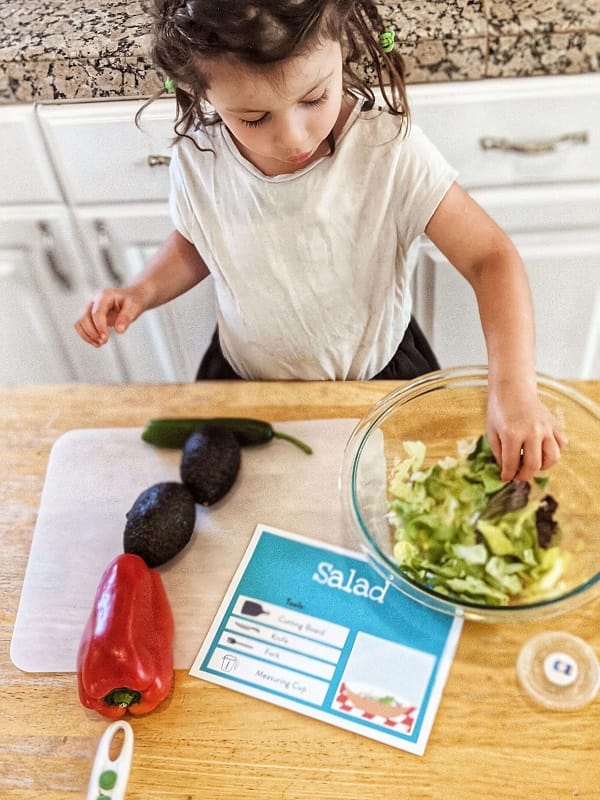The one thing that’s for sure about being a parent is that it’s unpredictable. The demands change from day to day and from child to child. With all that we’re trying to balance, eating mindfully may seem like something that’s completely out of reach, especially when you’re eating with the kids.
But paying attention to what we eat has so many benefits. So here’s a quick guide to mindful eating when you’re a busy parent.

What is Mindfulness Anyway?
It’s more than just an app on your phone that helps you elongate your breathe. Mindfulness is the process of being in the moment, without judgement. For young children especially, who are still working on the fine motor skills necessary for eating, being in the moment is crucial. They actually need to focus their attention on eating. This is one reason that distracted eating, especially in front of a screen, is really not recommend for children.
As adults, we’re also guilty of distracted eating. Taking lunch at your desk while finishing up work is an example of distracted eating. Eating in front of the TV (or really any screen) is another example. And of course, driving while eating is clearly distracted eating.
Whether you are just figuring out how to use a spoon, or are scarfing down breakfast so you can drive carpool, being distracted while eating is less than ideal.
So then, What is Mindful Eating?
Like the name implies, mindful eating means really paying attention to what you are putting in your mouth, without judgement. Some people have distorted this to mean chewing each bite twenty times before swallowing, but that’s just distracting yourself in a different way. According to the center for mindful eating, there are 4 basic parts:
- paying attention to how you feel emotionally while eating
- focusing on all the sensory input from your food
- realizing when you are hungry and full
- allowing yourself to like and dislike foods.

How to Eat Mindfully
Pay Attention to Emotions
Stress eating. Even if you haven’t done it, you’ve probably heard of it. This is eating when you’re feeling stressed, or depressed, even though you’re not hungry. The goal of eating mindfully is to notice how you feel while you’re eating, without the guilt. So keep checking in on yourself (and your kids) to notice how eating affects your mood.
How to do it:
- Notice your emotions. Before you’re about to eat something, ask yourself if you’re really hungry. Maybe you’re hungry and also still upset about last night’s football game. Maybe there’s still some residual stress from another hectic morning. Ask your kids how they feel when they sit down to eat also.
- Name your feelings. Emotions are hard to understand, but it’s important to label them. This is actually a fundamental part of mindfulness: acknowledging emotions without allowing them to cloud your judgement. Once you admit that you are sad and worried, you can separate that from your actions.
- Eat. Emotional eating isn’t necessarily a bad thing. In fact, when you feel stressed or worried or sad, sometimes a glass of wine or your favorite macaroni and cheese is exactly what you need. The important thing is to notice why you’re eating.

Focus on Senses
One of the best things about food is it’s sensuality. You can see, touch, smell and taste it. If you live with any loud chewers, then there’s a chance you can hear it too. Slowing down to enjoy everything food has to offer is a great way to eat more mindfully, and pay more attention to what you’re putting in your mouth.
How to do it:
- Notice the color. Ask your child to point to the green item on the plate.
- Look at the shape. Does the spaghetti remind you of something? What about the mashed potatoes?
- Breathe deeply. Can you guess some of the ingredients in your meal without even tasting it?
- Pay attention to mouthfeel. I have to admit that mouthfeel is one of my favorites. It’s actually something that chefs pay attention to. It refers to how the food actually feels in your mouth. Is it crunchy on the outside and soft on the inside? Does it feel grainy and gritty or silky smooth? Take a few bites and pick a word or two to describe the mouthfeel of what you’re eating.
Realize When you Are Hungry
Many young children are very good at this, but as we grow older, we learn to override our innate feelings of hunger. Instead of relying on our bodies to signal hunger and fullness, we rely on our eyes. For example, finishing the entire portion on your plate. Or grabbing a handful of pretzels every time you pass by the bowl. When you eat mindfully as a family, it’s a good chance to help each other notice hunger.
How to do it:
- Serve smaller portions. Especially for young children who may feel obligated to clean their plates, smaller portions are a great way to get back in touch with your stomach. When you’ve finished what’s on your plate, ask yourself if you’re still hungry before going in for another round.
- Respect when you (and others) are full. Yes, it’s great to encourage everyone to try new foods. And it can take quite a few tastes before a picky eater will like something new. But encouraging anyone to take “just a few more bites” isn’t mindful.
- Eating at mealtimes, instead of snacking. Feeling hungry isn’t actually a bad thing. It’s even beneficial sometimes to let yourself feel a little hungry, to help you remember what that’s like. This doesn’t mean that you should skip meals. Instead, try to space out your meals and snacks so that you’re just about hungry when it’s time to eat.

Allow yourself (and your kids) to dislike food.
We are all unique individuals with our own taste and style. Fortunately, there are plenty of food options to cater to any food preferences. Although some kids may love to eat broccoli and brussel sprouts, yours may not be as easy going. Being able to eat mindfully means allowing family members the freedom to say no to certain foods.
How to do it:
- Accept that you don’t need to like everything. Taste is very personal. Some people are just more sensitive to certain flavors or textures than others. Respect everyone’s food decisions.
- Being picky is ok. Part of raising a healthy eater is encouraging openness to new foods. But it’s also ok for a child to dislike something.
- Offer choices, but always include something for everyone. The more we respect everyone’s personal taste, then easier family meals are.
- Eating is meant to be enjoyable. Do you hate kale? Because I do. So I don’t eat it. There’s no reason to force yourself (or your kids) to eat something because it’s “healthy.” Thankfully, there are many options for healthy, nutritious food and chances are good that you and your family can find something to enjoy.
What About Intuitive Eating?
Intuitive eating has a lot in common with mindful eating. Both of them turn the focus onto paying attention to our food and our bodies. You have to be a more mindful eater in order to eat intuitively.
There are 10 basic principles of Intuitive Eating, but the TLDR version is eat when you’re hungry, stop when you’re full, eat for health and for pleasure and do not associate moral value with certain types of food. It all sounds very simple and basic, but the truth is that after years of ingraining certain eating patterns and habits, it can be quite a struggle to make peace with food, to enjoy eating without feeling guilty and most importantly to respect and heed the body’s signals of hunger and fullness.
How to Teach Healthy Eating Without Shame
Of course, as parents, we want to help our kids learn to trust their bodies when it comes to eating. Whether you want to call it being mindful, or intuitive eating, here are 5 ways to teach your kids to respect their bodies, and the food they’re eating.
1. All Foods Are Good Foods -
As adults, we tend to think of certain kinds of foods (mostly those that are high in sugar and fat) as “rewards.” This both encourages a mentality where sweet foods need to be earned, and teaches kids that certain foods are better than others.
Food should not be used to reward positive behavior, nor should it be taken away as a punishment. If you treat all foods as being good, then chances are your child will treat them that way as well.

2. Allow Everyone to Decide When They're Done
How many times do we hear parents or caregivers telling children that they need to have “one more bite” of chicken or eat at least 3 pieces of broccoli before they can leave the table? Of course this is all done with the best of intentions, but the downside is that it takes away a child’s ability to monitor his levels of hunger.
The more we encourage external signals for fullness, the less in tune our kids are with their own internal cues. So ditch the “clean plate club”. Each individual can determine for themselves when they are done.
3. Forbid Forbidden Foods
There is no “never” with foods (unless there is an allergy, health concern or religious reason for avoiding certain foods). There are of course foods we eat occasionally (such as birthday cake) and foods we eat all the time (like fresh fruits and veggies.)
Forbidden foods are tempting, and temptation can be hard to resist. When given the opportunity, children who are forbidden from eating certain foods will overindulge. There is a time a place to eat and enjoy all foods.
4. Avoid Moral Judgement
Classifying food as “good” and “bad” is pretty easy, but assigning morality is often complicated. Carrots aren’t “good” and french fries aren’t “bad”. Carrots are more nutritionally dense and that’s about all we can safely say without making judgement calls.
The logical extension of labeling food as “good” and “bad” is that people who eat “good” foods are “good” and people who eat “bad” foods are “bad.”
Instead, use phrases like “help you grow” or “keep you healthy”. In addition to being true, it helps clarify what is so “good” about certain foods.

5. Do As You Say
Kids are always watching us, so it’s important not only to make sure we help them develop healthy food attitudes, but to have them ourselves.
This means not having negative self-talk, or saying that you are being “good” because you are eating only salad.
It means saying no thank you to seconds if you are full, but taking another serving if you are still hungry.
It means showing our kids that we can enjoy both a salad and an ice cream sundae, and feel good about both.
The most important thing is that we focus on our relationship with our kids. That means not using negative emotions, like shame or coercion to get them to eat well. See our infographic on teaching healthy eating for more details.

